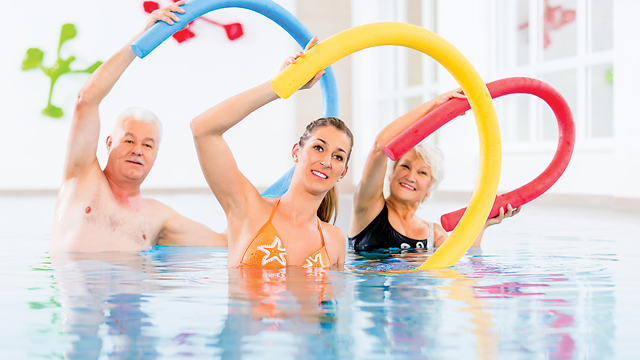Did you know just two-and-a-half hours per week of aerobic physical activity, like swimming, biking, or running can decrease the risk of chronic illness, leading to improved health for individuals with diabetes and heart disease? People report enjoying water-based exercise more than exercising on land while also being able to tolerate longer workouts in water without joint or muscle pain – in particular, water aerobics.
Aquatic programs are an excellent way for people to exercise in a low-impact environment because it is easier on the joints and muscles. This is good news for seniors with chronic diseases, such as rheumatoid arthritis and osteoporosis, which is a decrease in bone density as a person ages, but anyone, no matter his age can enjoy water aerobics. A benefit of exercising in the water is the natural buoyancy of our bodies, which removes much of the pressure that is normally on our joints and muscles.
A person with limited mobility is able to jog, stretch, and move through the water in ways he or she could never imagine on land. An indoor swimming pool is best, where the water temperature is controlled. Exercising in warm water provides many unique benefits and is a great way for individuals who would normally be unable to get quality exercise to actually strengthen themselves in new and exciting ways. Water-based exercise has also been known to help maintain bone health, particularly in older women. Swimming also boosts flexibility, especially in the neck, legs, arms and hips, leading to reduced back pain and sore muscles, as well as better posture and muscle coordination, according to the National Swimming Pool Foundation. People with arthritis or back pain will find that the warmth of the water allows them greater flexibility. And the good news is, the fuller range of motion is often noticeable for many hours after exercising in the pool.
Water aerobics maximizes resistance resulting in a core challenge. Muscles tend to tone easier, as every single muscle in the body is working hard to cut through that water, providing a resistance training of sorts. Building muscle strength can result in less flabby skin on the arms and legs for seniors in particular.
Because swimming is aerobic in nature, it boosts the health of the heart, leading to a reduction in coronary heart disease through lowered risk of inflammation. Water can even improve and maintain balance as it takes pressure off the spine. This form of exercise can relieve the wear and tear of joints and help you stay fit. Water can also have tremendous benefits for those with knee, hip, or shoulder pain in the water, allowing for cardiovascular and strength training.
Of course, you do not have to be sick or elderly to enjoy water exercise. Water aerobics is for everyone, especially athletes who are training for a marathon or who may be concerned about getting injured while training. For marathon runners, I recommend aqua running sessions in your workout. Water-based activities can increase flexibility, helping to prevent injuries for all athletes.
Beyond the physical benefits, for seniors in particular, this kind of physical activity can help reduce isolation. Group exercise programs are a very effective method to reduce senior isolation and loneliness, along with having the added benefit of improving physical health. The physical benefits of swimming are plenty, but the mind also benefits from regular aquatic activities in seniors. This popular activity is a natural stress reliever which can improve moods and fight off depression. Seniors also experience a heightened sense of fellowship when swimming in a public pool as they make new friends. Going for a swim at a family member’s home can create fun memories with children, grandchildren, spouses and friends, giving seniors important outlets for socialization.





